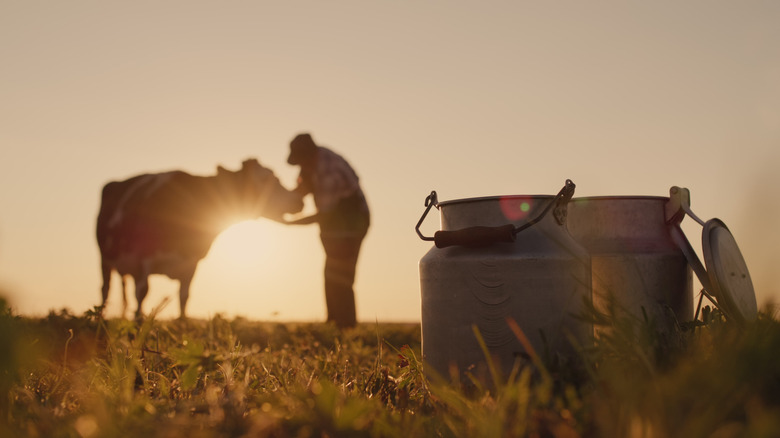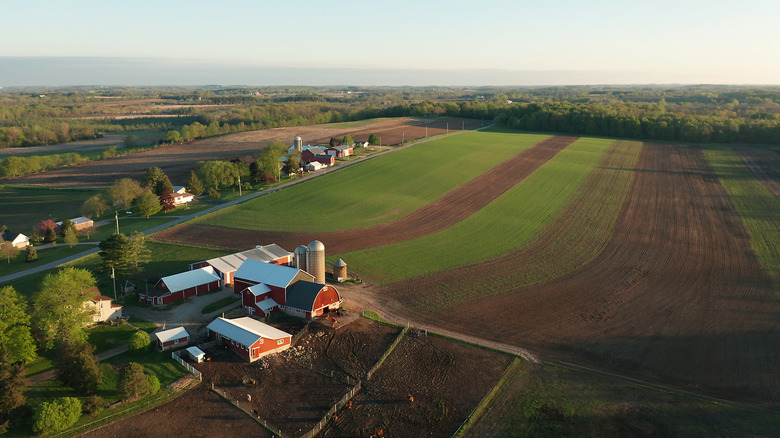Dairy cow numbers continue to decline in Australia due to increasing competition for land with beef and sheep producers. Dairy producers along Australia’s north coast continue to struggle with heavy rain and flooding. Cows are being moved to higher ground.
New Zealand dairy markets are happy due to the strong GDT, says DMN. The United Kingdom and New Zealand signed a trade deal, including a five-year period moving to full removal of tariffs on cheese and butter exports from New Zealand. Tariffs are eliminated on all UK exports, according to DMN.
Cheese vats were busy in January. You’ll recall that USDA’s preliminary data reported January milk production at 19.1 billion pounds, down 1.6% from January 2020. The January Dairy Products report shows which products got shorted and it wasn’t cheese. Total output hit 1.168 billion pounds, up 1.8% from December and 2.8% above January 2021. And, a lot of that went into the cooler, according to USDA’s Cold Storage report, in fact total stocks were up 3% from Jan. 2021.
Wisconsin produced 291.9 million pounds of the January total, down 0.9% from December but 2.8% above a year ago. California vats provided 194.6 million pounds, up 3.6% from December but 7.4% below a year ago. Idaho added 87.1 million pounds, down 1.3% from December, and 0.8% below a year ago.
Italian cheese totaled 489.1 million pounds, up 0.9% from December and 1.7% above a year ago.
American type cheese, at 479.6 million pounds, was up 4.7% from December and up 1.1% from a year ago.
Mozzarella output totaled 379.1 million pounds, up 1.1% from a year ago.
Cheddar, the daily traded cheese at the CME, totaled 337.4 million pounds, up 9.7 million pounds or 3.0% from December’s output, which was revised down 6.9 million pounds, and was down 9.5 million pounds or 2.7% from January 2021, fourth month in a row to be below the previous year.
Churns produced 195.2 million pounds of butter, up 15.2 million pounds or 8.4% from December, but 14.4 million pounds or 6.9% below a year ago, seventh consecutive month below a year ago. Stocks were down 33% from a year ago.
January yogurt output totaled 374.9 million pounds, up 2.8% from a year ago.
Dry whey production climbed to 80.3 million pounds, up 2.6 million pounds or 3.3% from December, but 3.7 million pounds or 4.4% below a year ago.
Dry whey stocks slipped to 56.4 million pounds, down 1.2% from December and were 10.9 million pounds or 16.3% below those a year ago.
Nonfat dry milk output climbed to 170.7 million pounds, up 2.9 million pounds or 1.8% from December but was down 27.3 million or 13.8% from a year ago.
Stocks climbed to 261.3 million pounds, up 9 million pounds or 3.6% from December, but were down 43.7 million pounds or 14.3% below those a year ago.
Skim milk powder amounted to 43.4 million pounds, up 5.1 million pounds or 13.5% from December and up 7.4 million or 20.6% above a year ago.
The report was viewed as slightly bearish however StoneX stated in its March 7 ‘Early Morning Update;’ “Given the recent increase in dairy cow slaughter levels, declines in milk collection in Europe, yields in the U.S., and poor weather in New Zealand and Australia, any increase in milk production will likely take longer than we anticipated. This stall in production levels likely has a far bigger long-term impact in the market than dairy product production numbers being slightly higher than we expected.”
The U.S. still has plenty for U.S. and global consumption. HighGround Dairy’s (HGD) Lucas Fuess reported details of January export data in the Mar. 14 ‘Dairy Radio Now’ broadcast. Technical difficulties interrupted the usual posting to the USDA website, he said, however HGD secured data from an alternative source, though it may be subject to some revision.
Cheese exports totaled 65.1 million pounds, up 16.5% from January 2021, highest January volume since 2014, according to Fuess, and that despite the port congestion issues that have been plaguing the industry.
Those issues have impacted nonfat dry milk a lot more, he said. Powder exports totaled 131 million pounds, down 5.5%, down for the second consecutive month regardless of the strong global demand. He said he believes that demand will remain strong and support the price and does not think the U.S. will price its way out of the market despite the rise in U.S. prices.
January butter exports totaled 7.8 million pounds, up 24.8%, and dry whey amounted to 26.8 million pounds, down 33.8%.
HGD says “The exports showed weakness across a wide swath of products, but strength in cheese, butter, and lactose was encouraging. Tough prior year comparable volume coupled with port congestion will limit the ability of exports to show impressive strength in the coming months,” however HGD warned. “Significant volume will continue to leave the U.S. as demand remains firm and U.S. prices remain a value buy,” HGD concludes.
Meanwhile, the Agriculture Department again lowered its estimate for 2022 milk production, citing lower dairy cow numbers and slower growth in milk per cow, and raised milk price projections in the latest World Agricultural Supply and Demand Estimates report (WASDE).
2022 production and marketings were estimated at 226.0 and 225.0 billion pounds respectively, down 1.2 billion pounds on production. If realized, 2022 production would be down 200 million pounds or 0.1% from 2021.
The fat basis import forecast was lowered on lower expected imports of cheese and butterfat products, while exports were reduced on lower shipments of whole milk powder and whey. The skim-solids basis import forecast was raised, primarily as higher imports of milk proteins more than offset weaker cheese imports. The export forecast was reduced on weaker expected sales of whey products and skim milk powders, according to USDA.
Price forecasts for cheese, butter, nonfat dry milk, and whey were raised from the previous month, based on current prices, lower expected production, and continued demand strength. The higher product prices resulted in both Class III and Class IV milk prices being raised.
Cheese is now projected to average $2.03 per pound in 2022, up 13 cents from last month’s estimate, and 35.55 cents above the 2021 average.
Butter was projected at $2.5750 per pound, up 18.5 cents from a month ago and 84.25 cents above 2021.
Nonfat dry milk was projected at $1.74 per pound, up 7.50 cents from last month’s estimate and 47.1 cents above the 2021 average.
Whey is projected to average 71 cents per pound, was up a half cent from last month’s estimate and 13.6 cents above the 2021 average.
The 2022 Class III milk price is projected to average $21.65 per hundredweight, up $1.35 from what was expected a month ago, and $4.57 above the 2021 average of $17.08.
The Class IV average was projected at $23.70, up $1.40 from a month ago, and $7.61 above the 2021 average of $16.09.
The war in Ukraine is especially impacting global grain markets and the USDA lowered its export data on corn and wheat from the region. Ukraine’s corn exports were reduced 6 million metric tons and the March 9 ‘Daily Dairy Report’ warned; “Even if other exporters, such as the U.S., increase shipments to partially offset lower Ukrainian exports, the resulting supply shortage is nonetheless expected to keep global corn prices elevated.”
The corn outlook is for increased food, seed, and industrial use, larger exports, and smaller stocks relative to last month. Corn used for ethanol was raised 25 million bushels to 5.35 billion. Exports were raised 75 million bushels to 2.5 billion, reflecting expectations of sharply lower Ukraine exports. The projected season-average farm price was raised 20 cents to $5.65 per bushel. Global coarse grain production was forecast 1.5 million tons higher to 1.499 billion.
Higher exports of soybeans are anticipated and lower ending stocks. Exports were raised 40 million bushels to 2.09 billion, with lower production and reduced exports for South America. Soybean ending stocks were projected at 285 million bushels, down 40 million from last month. With rising soybean oil prices, soybean oil used for biofuel was reduced.
The U.S. season-average soybean price was forecast at $13.25 per bushel, up 25 cents. The soybean meal price was forecast at $420 per short ton, up $10. Global soybean supply and demand forecasts include lower production, crush, exports, and stocks, according to the WASDE.
In the week ending February 26, 65,200 dairy cows were sent to slaughter, down 2,000 from the previous week, and 6,500 head or 9.1% below a year ago.
After jumping 20.50 cents the week before, the CME Cheddar blocks climbed to $2.2325 per pound Wednesday, highest since November 10, 2020, but closed Friday at $2.19, up 4 cents on the week and 40 cents above a year ago.
The barrels climbed to $2.0850 Wednesday, also the highest since November 10, 2020, but finished Friday at $2.01, also up 4 cents on the week, 45.75 cents above a year ago, and 18 cents below the blocks. Sales totaled 6 cars of block and 21 of barrel
The March 4 Dairy and Food Market Analyst cautions that foodservice sales are “losing momentum.” “Data from OpenTable show restaurant traffic decreased by 4.7% in the latest week versus pre-pandemic levels. This compares to mid-February when sales managed to move above pre-pandemic levels.”
Milk availability in the Midwest is mixed, according to Dairy Market News. Location has played a big part in recent months and not necessarily plants’ proximities to dairy farms. Milk handlers and cheese plant managers are working together to move milk loads, at discounts, o active plants, while others undergo maintenance downtime. A growing number of cheese plants are opting to use internally sourced milk unless spot milk loads are sub-Class, as Class III milk prices are $20 plus per cwt. Cheese sales continue steady to busier. Some cheesemakers think the bullish market push will slow interest, while others say buyers are actively trying to stay ahead of price increases, says DMN.
Cheese markets continued along their recent bullish trend in the West. Contacts report that loosening COVID restrictions and improving weather was leading to more food service sales and retail demand is steady. International demand remains strong as purchasers look to fill second and third quarter needs. U.S. prices remain competitively priced but port congestion continues to cause delays. Cheesemakers are running busy schedules but below capacity due to labor shortages and delayed deliveries of production supplies.
Cash butter shot up to $2.7775 per pound Wednesday, fell back 8.50 cents Thursday, but climbed back to a Friday finish at $2.71, up 2.50 cents on the week and 99.50 cents above a year ago, with 24 sales reported.
The spot market has rolled over to new crop butter, meaning only that which was produced after December 1 last year will be allowed and, as StoneX put it; “Add in an already tight stock situation and it will likely underpin the market.”
Butter producers continue to report accessible cream from within the region and the West. Seasonal milk yield increases will likely push extra cream onto the spot market, says DMN, but spring holiday-focused processing of dips, whips, cream cheese, and other staples could keep cream availability in check, if not tighten it. Some butter makers say they are in somewhat good shape regarding fall stocks but others are not. Staffing shortages remain a hurdle to full capacities but that varies plant to plant. DMN says “There are a number of questions pertaining to Ukraine and Russia. As fuel prices quickly increase, plant managers and others say hauling costs will add another barricade to smooth running operations.”
Cream demand is steady to higher in the West. Inventories are available but tightening, as butter and ice cream makers ramp up production for spring. Food service butter demand is trending higher; thanks to warmer weather and loosening COVID restrictions. Demand is also increasing in food service, as grocers purchase more for upcoming spring holidays. Export demand for butter is strong. Higher international prices and tight inventories are contributing to higher prices. Butter producers are running busy schedules in the region but labor shortages and delayed production supplies continue to prevent full capacity.
Grade A nonfat dry milk closed Friday at $1.84 per pound, down 3.25 cents on the week but 67 cents above a year ago, with 16 sales reported on the week.
Dry whey held all week at 75.75 cents per pound, 15.75 cents above a year ago, with only 1 sale reported on the week at the CME.
Western European milk output is seasonally increasing though the pace slowed in Germany and France. French production was unofficially noted to be below a year ago. Nearly 40% of Western European milk comes from Germany and France, according to DMN.
Source: farmersadvance.com






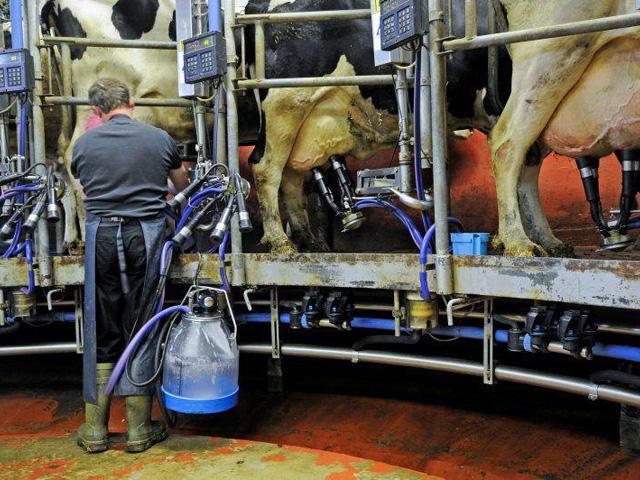
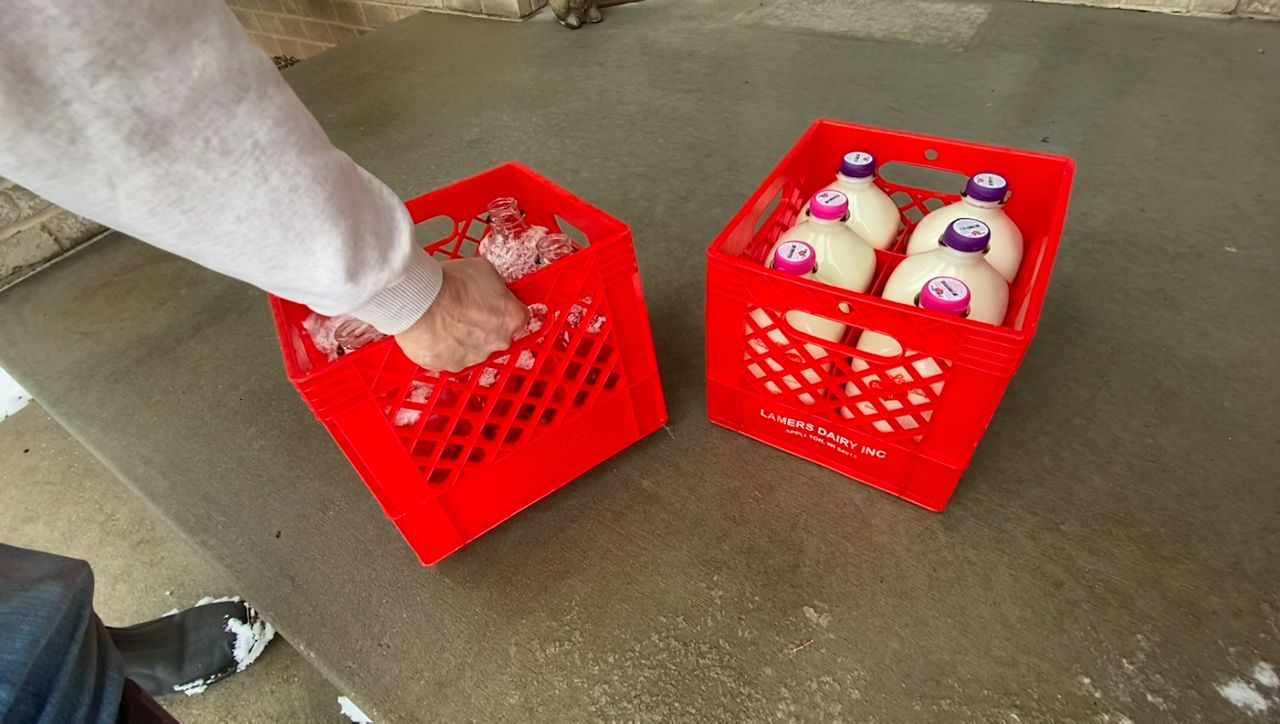
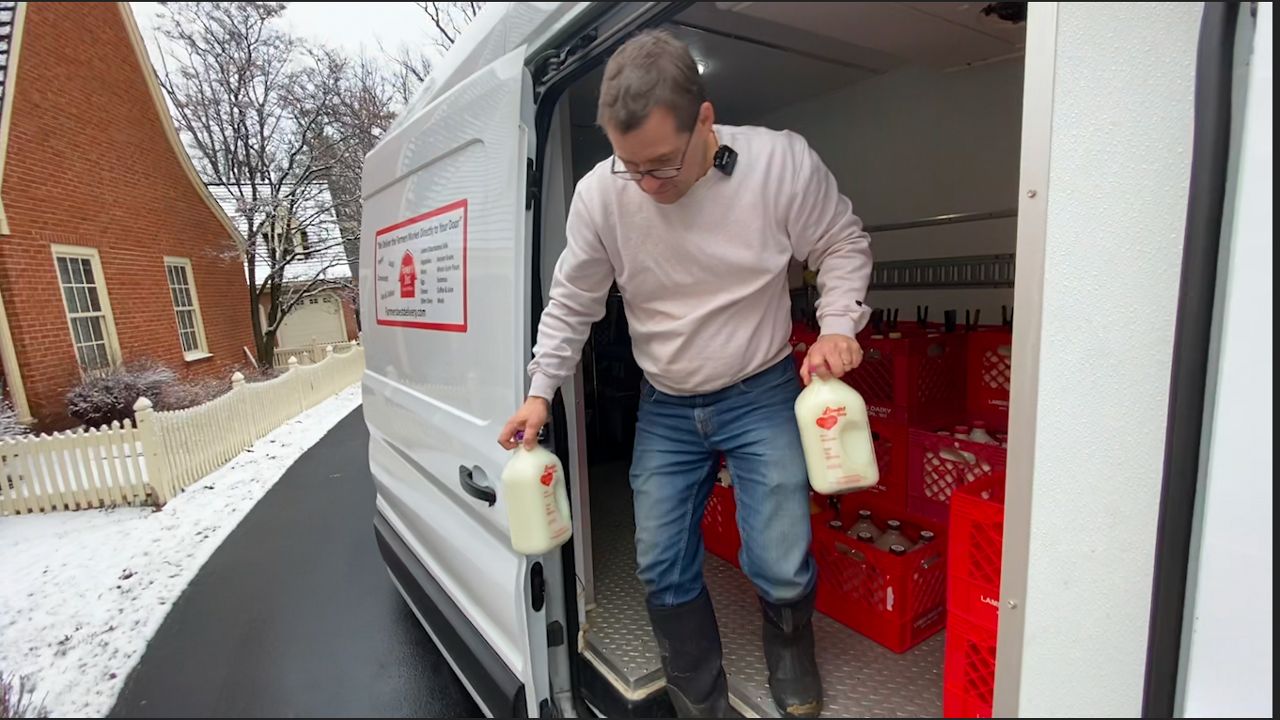





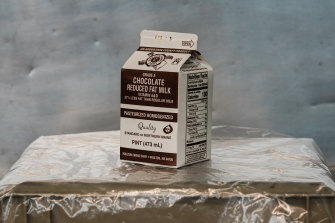


 “Something has to give and if the milk price doesn’t give, then the producers will,” says Oxfordshire dairy farmer David Christensen in a stark assessment of the peril his industry is facing as soaring costs push farm finances into the red.
“Something has to give and if the milk price doesn’t give, then the producers will,” says Oxfordshire dairy farmer David Christensen in a stark assessment of the peril his industry is facing as soaring costs push farm finances into the red.



